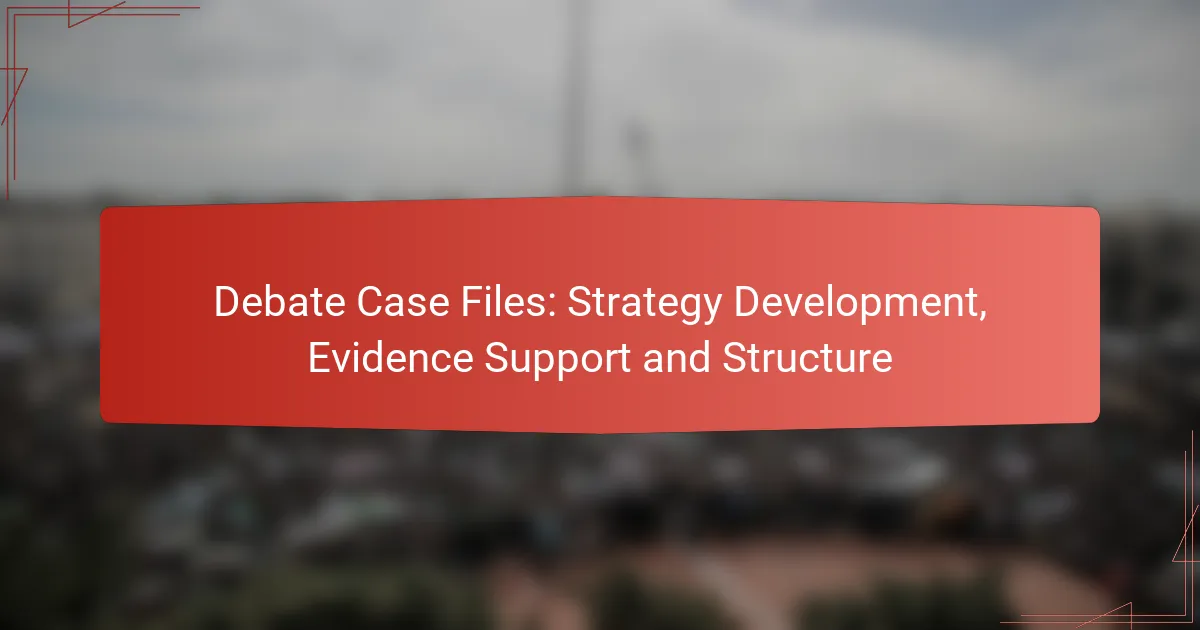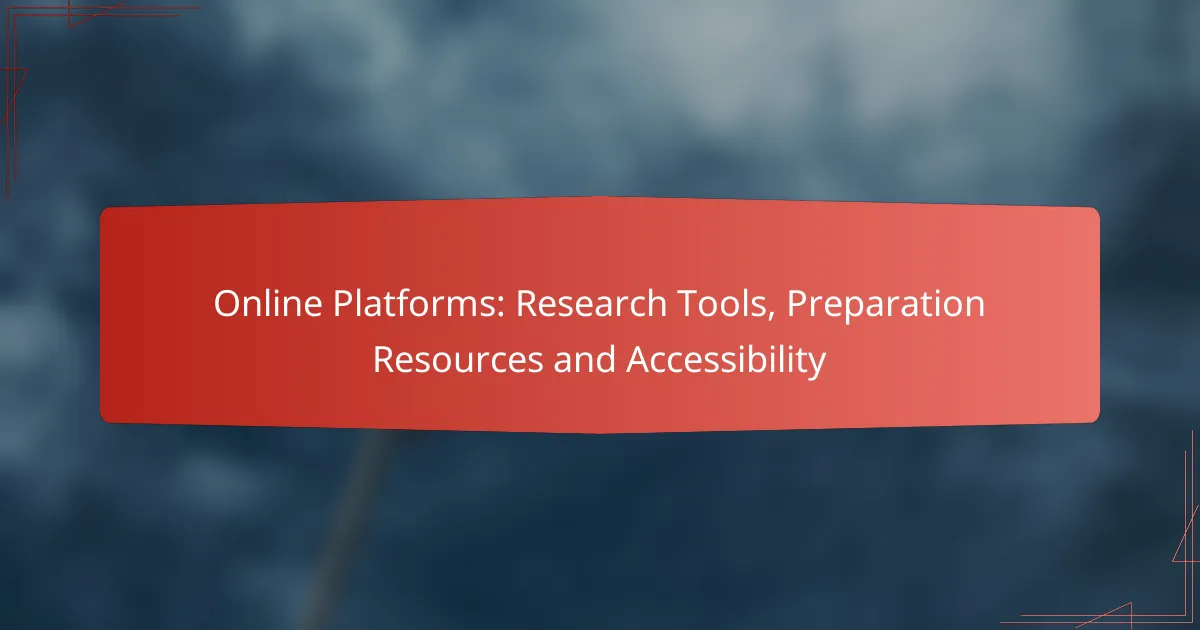Developing a successful debate case requires a strategic approach that combines thorough research, logical organization, and persuasive techniques. By incorporating strong evidence and anticipating counterarguments, debaters can create a compelling narrative that enhances their credibility and effectiveness. A well-structured case not only clarifies the argument but also engages judges and audiences, making it easier to follow and understand the position being presented.
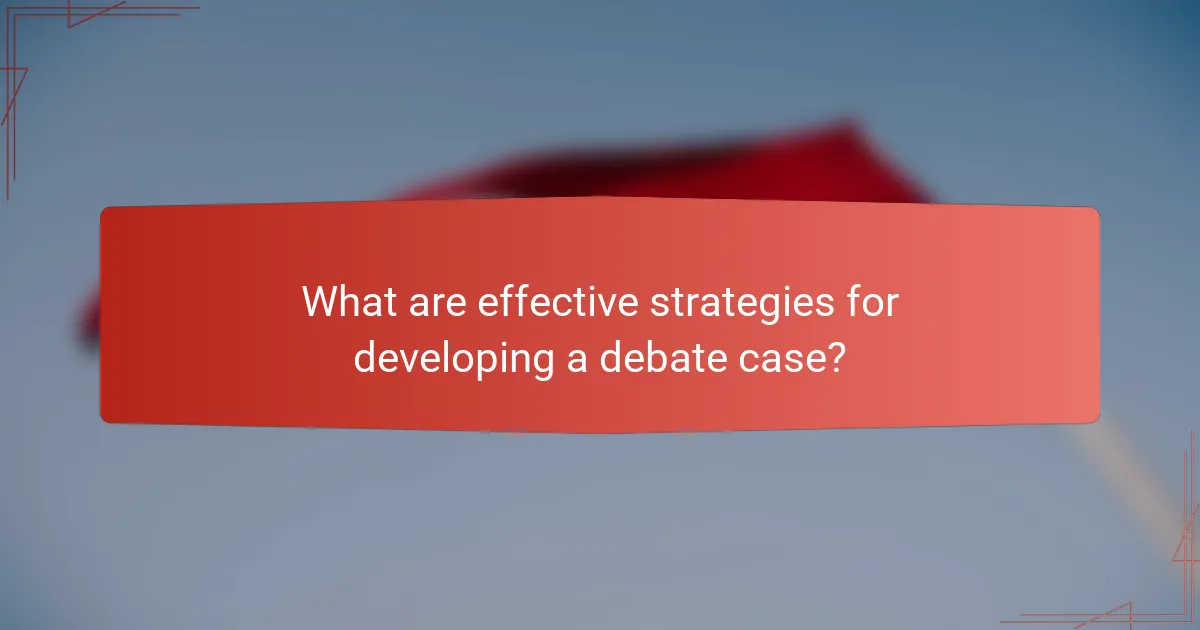
What are effective strategies for developing a debate case?
Effective strategies for developing a debate case involve thorough research, logical structure, and persuasive techniques. A well-crafted case not only presents strong arguments but also anticipates counterarguments, making it more robust and convincing.
Researching key arguments
Researching key arguments is essential for building a strong debate case. Start by identifying the main points that support your position, using credible sources such as academic journals, reputable news outlets, and expert analyses. Aim for a mix of qualitative and quantitative evidence to strengthen your claims.
Consider organizing your findings into categories that align with your main arguments. This approach helps in presenting a cohesive narrative during the debate. Utilize tools like citation management software to keep track of your sources and ensure proper referencing.
Identifying counterarguments
Identifying counterarguments is crucial for anticipating opposition and strengthening your case. Analyze the most common objections to your position and prepare responses that address these points directly. This not only demonstrates thorough understanding but also enhances your credibility as a debater.
Practice rebuttals to these counterarguments, focusing on logical reasoning and evidence. A well-prepared debater can effectively dismantle opposing views, making their own arguments appear more compelling and well-rounded.
Structuring the case logically
Structuring the case logically ensures clarity and flow in your argumentation. Start with a strong introduction that outlines your main thesis, followed by a series of points that build upon each other. Each argument should transition smoothly to the next, maintaining a clear narrative throughout.
Consider using a standard format such as the Toulmin model, which includes a claim, evidence, warrant, backing, and rebuttal. This structured approach helps in presenting a comprehensive case that is easy for the audience to follow.
Utilizing persuasive techniques
Utilizing persuasive techniques can significantly enhance the impact of your debate case. Techniques such as ethos (credibility), pathos (emotional appeal), and logos (logical reasoning) can be woven into your arguments to engage the audience effectively. For instance, sharing personal anecdotes can evoke empathy, while statistical data can appeal to logic.
Be mindful of your delivery as well; confident body language and vocal variety can reinforce your message. Practice these techniques to ensure they come across naturally during the debate.
Incorporating expert opinions
Incorporating expert opinions adds authority to your debate case. Citing recognized figures in your field can lend credibility to your arguments and persuade the audience to consider your viewpoint more seriously. Look for quotes or studies from experts that align with your key points.
Ensure that the experts you reference are relevant to the topic at hand and are respected within the community. This not only strengthens your case but also demonstrates thorough research and respect for the subject matter.
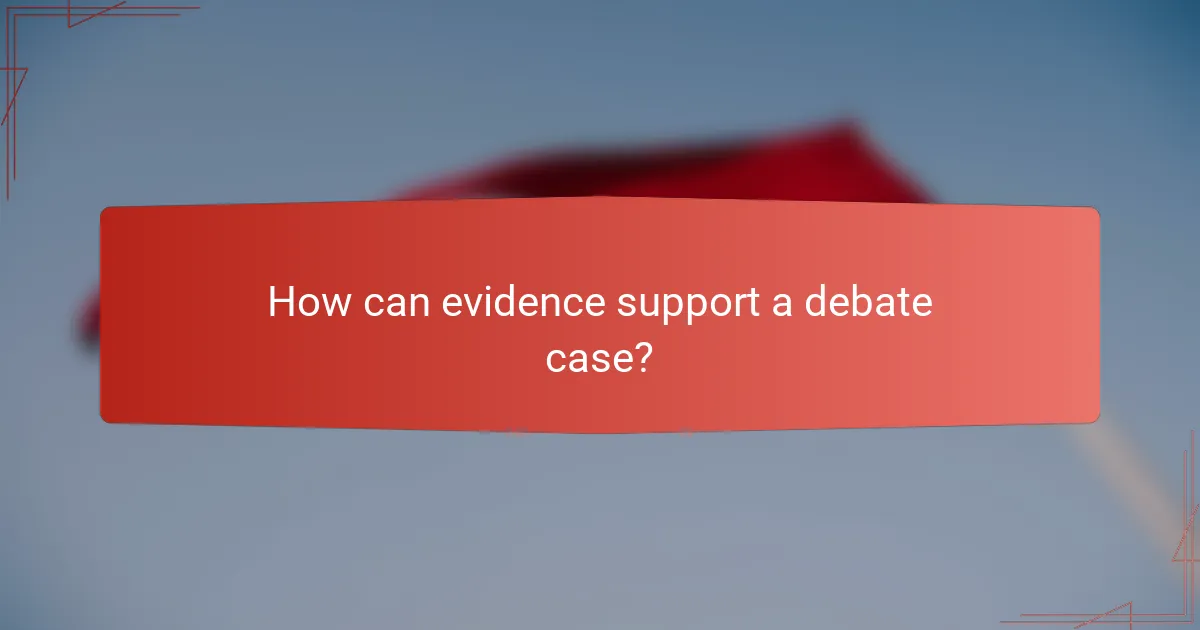
How can evidence support a debate case?
Evidence is crucial in supporting a debate case as it provides factual backing for arguments, enhancing credibility and persuasiveness. By utilizing various types of evidence, debaters can effectively substantiate their claims and counter opposing viewpoints.
Types of evidence: statistics and studies
Statistics and studies serve as powerful forms of evidence in debates. They offer quantifiable data that can illustrate trends, support claims, and demonstrate the impact of certain issues. For instance, citing a study that shows a significant increase in renewable energy usage can bolster an argument for environmental policies.
When using statistics, ensure they are relevant and up-to-date. Relying on outdated or misinterpreted data can weaken your case. Aim for statistics that are widely recognized and come from reputable sources to enhance their effectiveness.
Using credible sources
Credible sources are essential for supporting a debate case. They lend authority to your arguments and help establish trust with your audience. Sources such as peer-reviewed journals, government reports, and established news organizations are typically considered reliable.
To evaluate a source’s credibility, check the author’s qualifications, the publication’s reputation, and the presence of citations. Avoid using sources that lack transparency or have a known bias, as they can undermine your argument.
Quoting experts and authorities
Quoting experts and authorities can significantly strengthen your debate case. Expert opinions provide weight to your arguments and can clarify complex issues for the audience. For example, referencing a leading scientist’s opinion on climate change can enhance the legitimacy of your stance.
When quoting, ensure you accurately represent the expert’s views and provide context for their statements. Misquoting or taking statements out of context can lead to misunderstandings and weaken your position.
Presenting case studies
Case studies offer real-world examples that can illustrate the practical implications of your arguments. They help to contextualize abstract concepts and demonstrate how theories apply in specific situations. For instance, a case study on a successful public health initiative can effectively support arguments for similar programs.
When presenting case studies, focus on the most relevant details that align with your argument. Highlight key outcomes and lessons learned to make your case more compelling. Ensure that the case studies are recent and applicable to the current debate topic to maintain relevance.
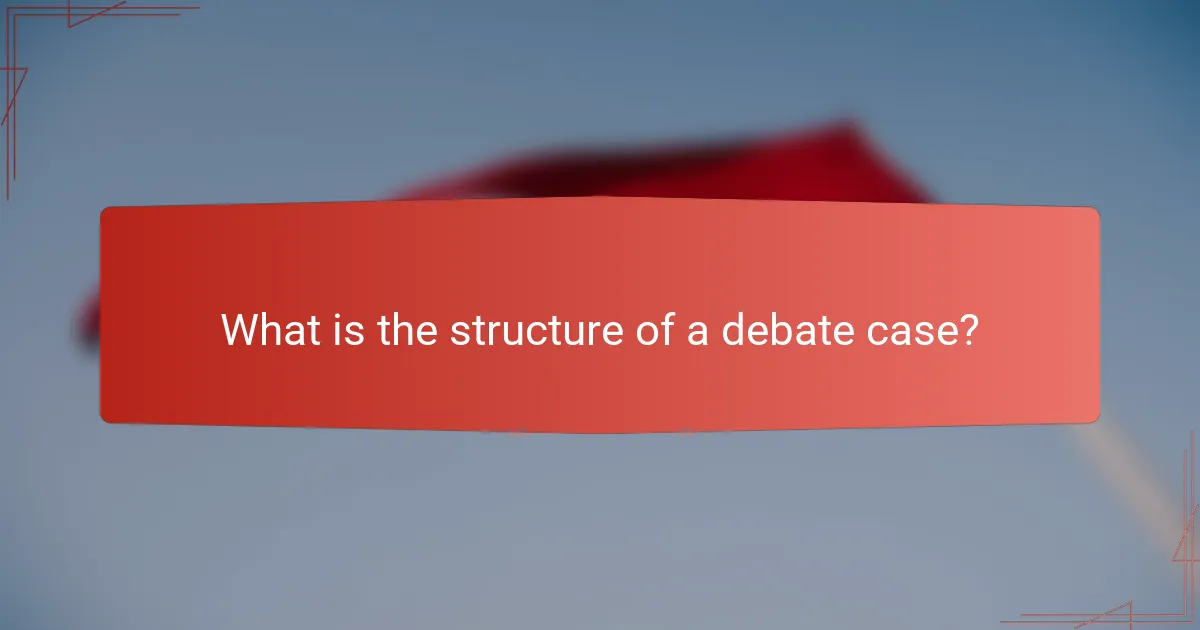
What is the structure of a debate case?
The structure of a debate case is a systematic framework that organizes arguments, evidence, and counterpoints to effectively present a position. A well-structured case enhances clarity and persuasiveness, making it easier for judges and audiences to follow the argumentation.
Introduction and thesis statement
The introduction sets the stage for the debate case by presenting the topic and the thesis statement. The thesis should clearly articulate the main position being argued, providing a roadmap for the audience on what to expect.
For example, if debating climate change policies, the thesis might state, “Implementing renewable energy sources is essential for sustainable development.” This statement establishes a clear stance that guides the subsequent arguments.
Main arguments and supporting evidence
Main arguments form the backbone of the debate case, each supporting the thesis. Each argument should be distinct and logically structured, often presented in a sequence that builds upon the previous points.
Supporting evidence is crucial; it can include statistics, expert opinions, and real-world examples. For instance, citing studies that show a significant reduction in carbon emissions from renewable energy can strengthen the argument.
Counterarguments and rebuttals
Addressing counterarguments demonstrates a thorough understanding of the topic and enhances credibility. Identify potential opposing views and present them fairly before offering rebuttals that refute these points.
For example, if a counterargument claims that renewable energy is too costly, a rebuttal could highlight long-term savings and government incentives that make it financially viable. This approach shows preparedness and strengthens the overall case.
Conclusion and call to action
The conclusion summarizes the main points and reinforces the thesis. It should succinctly restate why the arguments presented are compelling and valid.
A strong call to action encourages the audience to adopt the proposed position or take specific steps. For instance, urging policymakers to prioritize renewable energy investments can leave a lasting impact and motivate change.
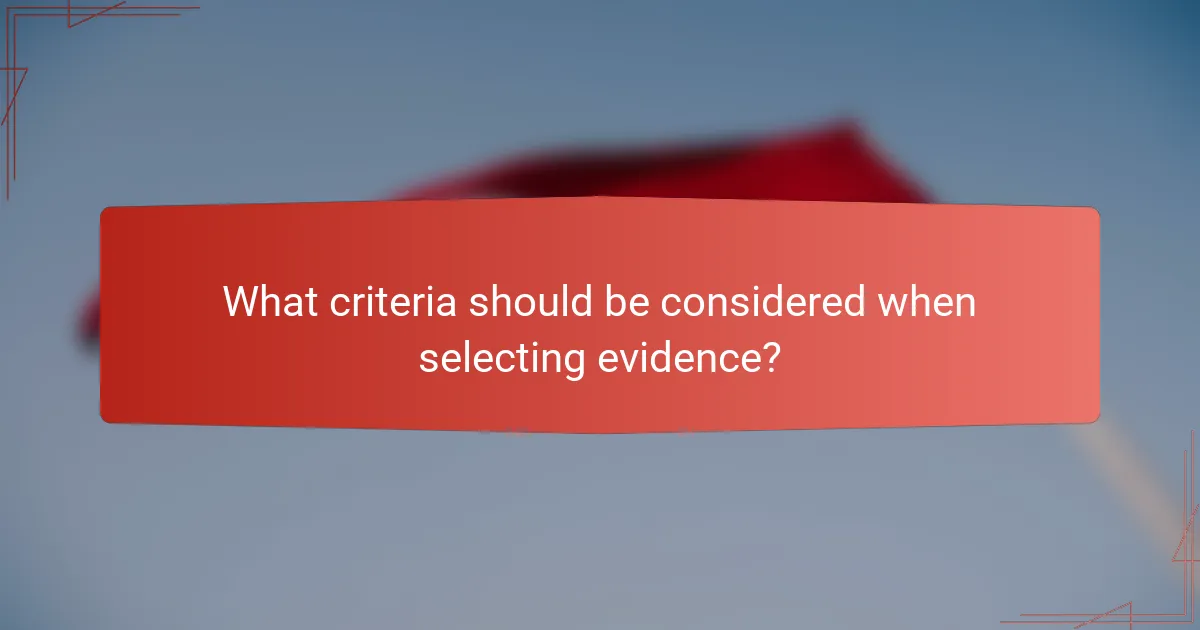
What criteria should be considered when selecting evidence?
When selecting evidence for a debate case, it is essential to consider its relevance, credibility, and timeliness. These criteria ensure that the evidence effectively supports your arguments and resonates with the audience.
Relevance to the topic
Relevance refers to how closely the evidence aligns with the debate topic. Evidence should directly support your claims and address the specific issues at hand. For instance, if debating climate change, statistics on carbon emissions would be more relevant than unrelated economic data.
To evaluate relevance, ask whether the evidence answers the key questions of the debate. If it does not contribute to your argument or counter the opposing side, it may not be worth including.
Credibility of the source
The credibility of the source is crucial in establishing trust in the evidence presented. Reliable sources often include academic journals, government reports, and reputable organizations. For example, a study published in a peer-reviewed journal carries more weight than a blog post.
When assessing credibility, consider the author’s qualifications, the publication’s reputation, and whether the information has been peer-reviewed. Avoid using sources that lack transparency or have a history of bias.
Timeliness of the information
Timeliness refers to how current the evidence is and its relevance to the ongoing discourse. In fast-evolving fields like technology or health, using outdated information can undermine your argument. Aim for evidence that is recent and reflects the latest developments.
As a rule of thumb, prioritize sources published within the last few years, especially for topics that change rapidly. For historical debates, older evidence may still be valid, but ensure it is contextualized within the current understanding of the topic.
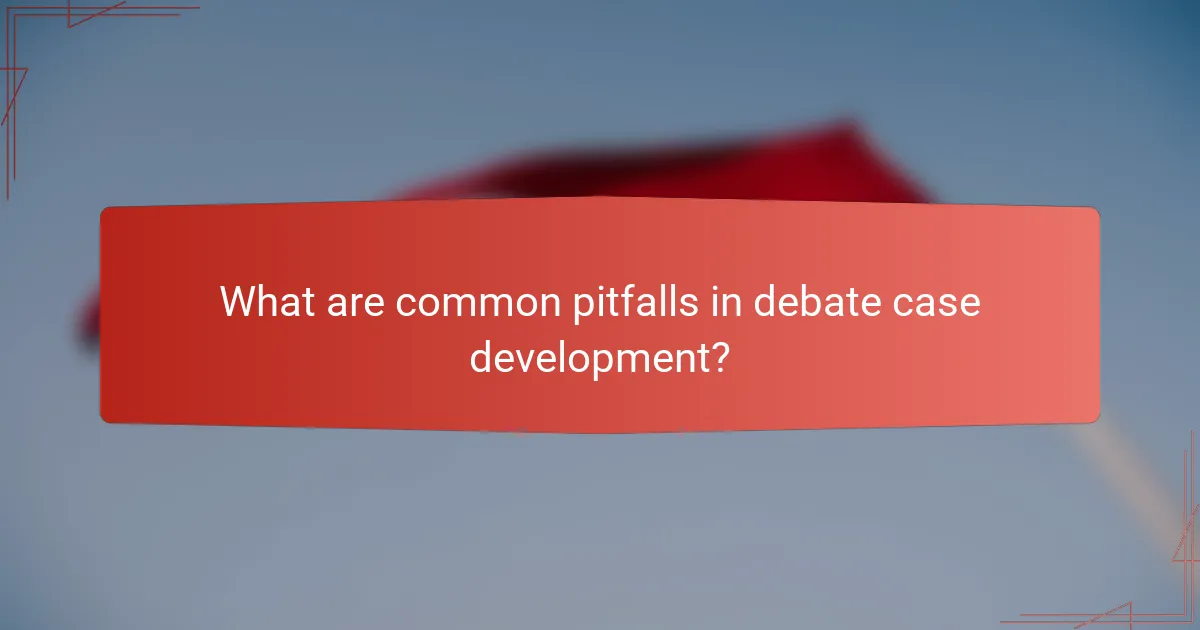
What are common pitfalls in debate case development?
Common pitfalls in debate case development include lack of clarity, insufficient evidence, and poor organization. These issues can weaken arguments and hinder effective communication, ultimately affecting the overall impact of the case.
Insufficient Evidence
One major pitfall is relying on weak or insufficient evidence to support claims. Debaters should ensure they use credible sources and relevant data to back their arguments. A good rule of thumb is to have at least two to three strong pieces of evidence for each major point.
For example, if arguing about climate change, citing scientific studies and expert opinions can strengthen the case. Avoid anecdotal evidence, as it often lacks the rigor needed for persuasive debate.
Poor Structure
A disorganized case can confuse judges and audiences, making it difficult for them to follow the arguments. A clear structure typically includes an introduction, main arguments, counterarguments, and a conclusion. Each section should logically flow into the next.
Using signposting language, such as “first,” “next,” and “finally,” can help maintain clarity. Consider creating an outline before drafting to ensure that all points are covered and presented in a coherent manner.
Lack of Engagement
Failing to engage the audience or judges can lead to a lack of interest in the case. Debaters should aim to connect with their audience through compelling storytelling and relatable examples. This can make arguments more memorable and persuasive.
Incorporating rhetorical questions or direct appeals can enhance engagement. For instance, asking the audience to consider the implications of a policy can prompt deeper reflection and involvement in the debate.
Neglecting Counterarguments
Ignoring potential counterarguments can weaken a case significantly. Debaters should anticipate opposing views and address them within their case. This demonstrates thorough understanding and preparation, which can enhance credibility.
When presenting counterarguments, it’s effective to acknowledge them respectfully before refuting them with strong evidence. This strategy not only strengthens the original argument but also shows the debater’s critical thinking skills.
